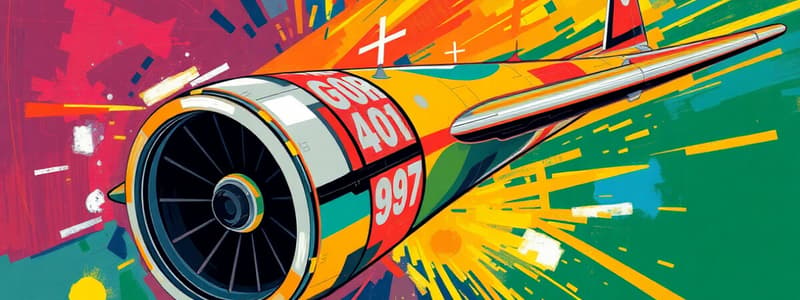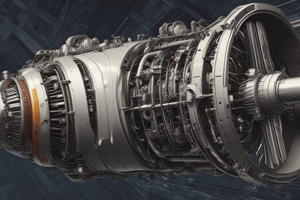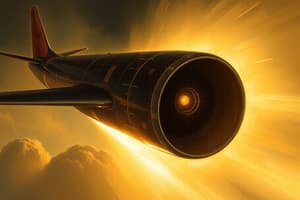Podcast
Questions and Answers
What principle describes the behavior of a balloon flying wildly as air rushes out?
What principle describes the behavior of a balloon flying wildly as air rushes out?
- Archimedes' principle
- Bernoulli's principle
- Newton's reaction principle (correct)
- Pascal's theorem
In what year was Dr. Frank Whittle granted his first patent for a jet engine?
In what year was Dr. Frank Whittle granted his first patent for a jet engine?
- 1942
- 1929
- 1930 (correct)
- 1935
Which aircraft was powered by two turbojet engines and flew for the first time in 1942?
Which aircraft was powered by two turbojet engines and flew for the first time in 1942?
- Boeing 747
- Concorde
- Bell XP-59 Airacomet (correct)
- Gloster E28/39
What was the approximate thrust produced by Whittle's first turbojet engine?
What was the approximate thrust produced by Whittle's first turbojet engine?
Which aircraft model completed the first flight of the turbojet engine?
Which aircraft model completed the first flight of the turbojet engine?
How fast do the majority of current commercial jet aircraft typically cruise?
How fast do the majority of current commercial jet aircraft typically cruise?
What limitation did the Bell XP-59 Airacomet face that prevented its combat use?
What limitation did the Bell XP-59 Airacomet face that prevented its combat use?
What was the primary function of the engines developed by Dr. Frank Whittle?
What was the primary function of the engines developed by Dr. Frank Whittle?
What was the significant achievement of Hans Von Ohain in jet propulsion?
What was the significant achievement of Hans Von Ohain in jet propulsion?
What does the Concorde represent in aviation history?
What does the Concorde represent in aviation history?
What principle is applied in various propulsive devices used in aviation?
What principle is applied in various propulsive devices used in aviation?
Which company was awarded a contract to develop a gas turbine engine in 1941?
Which company was awarded a contract to develop a gas turbine engine in 1941?
Which of the following does NOT fall under the types of jet propulsion mentioned?
Which of the following does NOT fall under the types of jet propulsion mentioned?
What was the time period during which the Concorde was in service?
What was the time period during which the Concorde was in service?
What is a key characteristic of a ramjet engine?
What is a key characteristic of a ramjet engine?
What advantage has contributed to the increased use of twin-engine aircraft?
What advantage has contributed to the increased use of twin-engine aircraft?
What was a key limitation of military aviation development in the United States compared to other regions?
What was a key limitation of military aviation development in the United States compared to other regions?
Which type of engine is typically considered more useful than a ramjet?
Which type of engine is typically considered more useful than a ramjet?
What is the main advantage of a gas turbine engine?
What is the main advantage of a gas turbine engine?
What distinguishes pulsejet engines from ramjets?
What distinguishes pulsejet engines from ramjets?
What is the function of the combustor section in a turbojet engine?
What is the function of the combustor section in a turbojet engine?
Which of the following is NOT a common type of gas turbine engine?
Which of the following is NOT a common type of gas turbine engine?
What limitation does a ramjet engine face?
What limitation does a ramjet engine face?
In a turbojet engine, what happens to the air after entering through the inlet duct?
In a turbojet engine, what happens to the air after entering through the inlet duct?
What causes the compressed air in a turbojet engine to expand?
What causes the compressed air in a turbojet engine to expand?
What happens to the air after it moves past the turbines in a turbojet engine?
What happens to the air after it moves past the turbines in a turbojet engine?
What is the primary purpose of thrust in a turbojet engine?
What is the primary purpose of thrust in a turbojet engine?
What role do the turbine wheels play in the operation of a turbojet engine?
What role do the turbine wheels play in the operation of a turbojet engine?
What is a characteristic of rocket-assisted takeoff (RATO) devices?
What is a characteristic of rocket-assisted takeoff (RATO) devices?
How does the air’s velocity change as it flows through the turbojet engine?
How does the air’s velocity change as it flows through the turbojet engine?
In turboprop powerplants, what type of aircraft commonly utilizes them?
In turboprop powerplants, what type of aircraft commonly utilizes them?
What main factor determines the thrust produced by a turbojet engine?
What main factor determines the thrust produced by a turbojet engine?
What is a turboprop engine primarily designed to deliver power to?
What is a turboprop engine primarily designed to deliver power to?
What major advantage do turbofan engines have over turbojet engines?
What major advantage do turbofan engines have over turbojet engines?
In a turbofan engine, where can the fan be mounted?
In a turbofan engine, where can the fan be mounted?
Why is reduction gearing necessary in turboprop engines?
Why is reduction gearing necessary in turboprop engines?
What characteristic do turboprop engines provide at speeds between 300 and 400 miles per hour?
What characteristic do turboprop engines provide at speeds between 300 and 400 miles per hour?
What are the primary benefits of using turboprop engines in business and commuter aircraft?
What are the primary benefits of using turboprop engines in business and commuter aircraft?
Which of the following terms is NOT commonly associated with discussing bypass engines?
Which of the following terms is NOT commonly associated with discussing bypass engines?
What operational feature allows turbofan engines to utilize both core and bypass air streams?
What operational feature allows turbofan engines to utilize both core and bypass air streams?
What does the bypass ratio of a turbofan engine compare?
What does the bypass ratio of a turbofan engine compare?
Which type of turbofan engine has fans mounted on the aft turbine?
Which type of turbofan engine has fans mounted on the aft turbine?
What is a characteristic of high-bypass turbofan engines?
What is a characteristic of high-bypass turbofan engines?
What does the term 'thrust ratio' refer to in turbine engines?
What does the term 'thrust ratio' refer to in turbine engines?
How does fan diameter affect a turbofan engine's performance?
How does fan diameter affect a turbofan engine's performance?
Which of the following correctly categorizes medium-bypass turbofan engines?
Which of the following correctly categorizes medium-bypass turbofan engines?
What effect do full fan ducts have on a turbofan engine's performance?
What effect do full fan ducts have on a turbofan engine's performance?
What is a distinguishing feature of low-bypass turbofan engines?
What is a distinguishing feature of low-bypass turbofan engines?
Flashcards
First successful turbojet engine
First successful turbojet engine
The Whittle W1, patented by Frank Whittle in 1930, which completed its first flight in 1941.
Jet engine thrust
Jet engine thrust
The force pushing an aircraft forward. Early jet engines produced around 1000-1650 pounds of force.
Bell XP-59 'Airacomet'
Bell XP-59 'Airacomet'
The first American jet-powered aircraft, powered by two turbojet engines, which proved jet-powered flight in 1942.
Jet propulsion
Jet propulsion
Signup and view all the flashcards
Commercial aircraft
Commercial aircraft
Signup and view all the flashcards
Turbojet engine
Turbojet engine
Signup and view all the flashcards
Frank Whittle
Frank Whittle
Signup and view all the flashcards
Gloster E28/39
Gloster E28/39
Signup and view all the flashcards
First Jet-Powered Flight
First Jet-Powered Flight
Signup and view all the flashcards
Supersonic Speed
Supersonic Speed
Signup and view all the flashcards
Gas Turbine Engine
Gas Turbine Engine
Signup and view all the flashcards
GE-1A Engine
GE-1A Engine
Signup and view all the flashcards
Mach one
Mach one
Signup and view all the flashcards
Concorde
Concorde
Signup and view all the flashcards
Types of Jet Propulsion
Types of Jet Propulsion
Signup and view all the flashcards
Ramjet
Ramjet
Signup and view all the flashcards
Ramjet's operation
Ramjet's operation
Signup and view all the flashcards
Ramjet's limitation
Ramjet's limitation
Signup and view all the flashcards
Pulsejet
Pulsejet
Signup and view all the flashcards
Pulsejet's advantage
Pulsejet's advantage
Signup and view all the flashcards
Gas Turbine Engine Types
Gas Turbine Engine Types
Signup and view all the flashcards
Turbojet engine operation
Turbojet engine operation
Signup and view all the flashcards
What powers the compressor in a turbojet engine?
What powers the compressor in a turbojet engine?
Signup and view all the flashcards
What determines the thrust of a turbojet engine?
What determines the thrust of a turbojet engine?
Signup and view all the flashcards
Turbojet engine thrust
Turbojet engine thrust
Signup and view all the flashcards
RATO devices
RATO devices
Signup and view all the flashcards
Turboprop engines
Turboprop engines
Signup and view all the flashcards
Turbojet vs. Turboprop
Turbojet vs. Turboprop
Signup and view all the flashcards
Why are RATO devices used?
Why are RATO devices used?
Signup and view all the flashcards
Reduction Gear System
Reduction Gear System
Signup and view all the flashcards
Why are turboprop engines used?
Why are turboprop engines used?
Signup and view all the flashcards
Fuel Efficiency of Turboprop Engines
Fuel Efficiency of Turboprop Engines
Signup and view all the flashcards
Forward-Fan Engine
Forward-Fan Engine
Signup and view all the flashcards
Aft-Fan Engine
Aft-Fan Engine
Signup and view all the flashcards
Bypass Engine
Bypass Engine
Signup and view all the flashcards
Thrust Ratio
Thrust Ratio
Signup and view all the flashcards
Bypass Ratio
Bypass Ratio
Signup and view all the flashcards
Low Bypass Engine
Low Bypass Engine
Signup and view all the flashcards
Medium Bypass Engine
Medium Bypass Engine
Signup and view all the flashcards
High Bypass Engine
High Bypass Engine
Signup and view all the flashcards
Fan Diameter & Bypass Ratio
Fan Diameter & Bypass Ratio
Signup and view all the flashcards
Fan Diameter & Thrust Ratio
Fan Diameter & Thrust Ratio
Signup and view all the flashcards
Full Fan Ducts
Full Fan Ducts
Signup and view all the flashcards
Study Notes
Newton's Third Law and Jet Propulsion
- Newton's third law states that for every action, there is an equal and opposite reaction.
- Jet propulsion uses this law by accelerating a quantity of air through a nozzle.
- The action is accelerating the air, and the reaction is the forward movement.
- Squids use jet propulsion to move through water.
Hero's Aeolipile
- In 250 B.C., Hero, a mathematician, created a toy that used jet reaction.
- The aeolipile was a covered kettle heated to produce steam.
- Steam was directed through vertical tubes into a spherical container.
- Discharge tubes, arranged radially, caused the sphere to rotate.
History of Jet Propulsion
- In 1900, Dr. Sanford Moss wrote a thesis on gas turbines.
- Dr. Moss worked for General Electric in England and contributed to turbo-supercharger design.
- Dr. Frank Whittle of England received the first patent for a jet engine in 1930.
- Eleven years later, his turbojet engine completed its first flight.
- The first practical jet-powered flight was accomplished by Hans von Ohain in 1939.
Jet Propulsion Today
- Most commercial aircraft today use jet propulsion and exceed 600 miles per hour.
- Supersonic aircraft like the Concorde have traveled at speeds over Mach 1.
- Jet propulsion is also commonly used in business jets.
Types of Jet Propulsion
- Rockets are non-air-breathing engines that carry their own fuel and oxidizer.
- Ramjets are air-breathing engines with no moving parts. They require high speed to produce thrust.
- Pulsejets use shutter valves to accelerate air and create thrust. They can produce thrust before reaching high speeds.
- Gas turbine engines are the most practical form of jet engines today. They are used in most commercial and military aircraft.
Gas Turbine Engines
- Turbojets, turboprops, turboshafts, and turbofans are the main types.
- Turbojets produce thrust directly by accelerating exhaust gases.
- Turboprops use a turbine to drive a propeller.
- Turboshafts use a turbine to drive a shaft, commonly for helicopters or auxiliary power units (APUs).
- Turbofans use a large fan for maximum efficiency.
Engine Components
- The seven basic sections in a jet engine are: Air inlet, Compressor, Combustion, Turbine, Exhaust, Accessory, Auxiliary
Studying That Suits You
Use AI to generate personalized quizzes and flashcards to suit your learning preferences.




